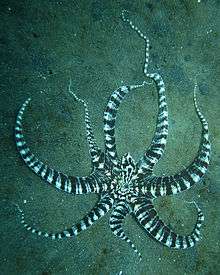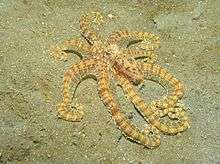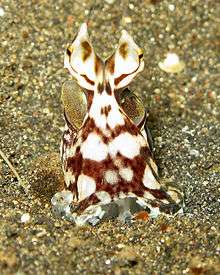Mimic octopus
The mimic octopus (Thaumoctopus mimicus) is an Indo-Pacific species of octopus from the Indo-Pacific region. Like other octopuses, it uses its chromatophores to disguise itself with its background. However, it is noteworthy for being able to impersonate a wide variety of other marine animals.[2] Although many animals mimic either their environment or other animals to avoid predation, the mimic octopus and its close relative the wunderpus are the only ones known to actively imitate a number of animals in order to elude predators.[3]
| Mimic octopus | |
|---|---|
 | |
| Scientific classification | |
| Kingdom: | Animalia |
| Phylum: | Mollusca |
| Class: | Cephalopoda |
| Order: | Octopoda |
| Family: | Octopodidae |
| Genus: | Thaumoctopus Norman & Hochberg, 2005[1] |
| Species: | T. mimicus |
| Binomial name | |
| Thaumoctopus mimicus | |
Etymology
The mimic octopus' generic name is derived from Greek θαῦμα thaûma, meaning "miracle" or "marvel" and ὀκτώπους, a compound form of ὀκτώ (oktō, "eight") and πούς (pous, "foot"). Its specific name mimicus alludes to its ability to disguise itself as another animal.
Appearance
The mimic octopus is a smaller octopus, growing to a total length of about 60 cm (2 ft), including arms, with a diameter approximately that of a pencil at their widest. Small horns protrude from each eye. The octopus' natural color is light brown/beige, but it usually takes on a more noticeable hue of striped white and brown to scare off predators by imitating poisonous species and vicious, territorial sea creatures. Its ability to change shape is the reason it was named the "mimic" octopus, which is its main defense besides camouflage.
Habitat and range

The mimic octopus was first discovered off the coast of Sulawesi, Indonesia in 1998 on the bottom of a muddy river mouth.[4] It has since been found to inhabit the Indo-Pacific, ranging from the Red Sea in the west to New Caledonia in the east, and Gulf of Thailand and the Philippines in the north to the Great Barrier Reef in south.[1][5][6] Most documented records are from Indonesia.[5] It is primarily found in areas with sand or silt at depths of less than 15 m (49 ft).[2] It prefers obscuring murky and muddy sea floors to blend in with its natural brown-beige coloring.
Behavior
The mimic octopus uses a jet of water through its funnel to glide over the sand while searching for prey, typically small fish, crabs, and worms. It prefers river mouths and estuaries, as opposed to reefs which are usually preferred as shelter by other types of octopus. This is due to its ability to impersonate toxic animals, putting it at less risk of predation than others in the open.

Mimic octopuses have been observed mimicking numerous different species of animals, some animals being mimicked more often than others. Among the animals mimicked are lion fish (the octopus holds its arms out radially to mimic the fish's spines), sea snake (hiding 6 of its arms, it holds the remaining 2 parallel to each other)[7], jellyfish (by inflating its mantle and trailing its arms behind it), and zebra sole (holding all 8 arms behind it as it uses its siphon to swim). The octopus' mimicry of flatfish may be its preferred guise; in a period of 5 days nearly 500 instances of flatfish mimicry were seen.[8] Not only does the mimic octopus use its ability to defend from predators, it also uses aggressive mimicry to approach wary prey, for example mimicking a crab as an apparent mate, only to devour its deceived suitor.
The mimic octopus retains the ability to camouflage with its sandy environment. It was also observed to mimic sessile animals such as small sponges, tube-worm tubes, or colonial tunicates.[9]
The octopus may be able to intelligently use its mimicry based on the situation. For example, an octopus which was being harassed by damselfish mimicked a banded sea snake, a damselfish predator.[10] It decides which mimicry behavior would be most appropriate and acts upon it.
Feeding
The mimic octopus can either be classified as a hunter or a forager. It is believed to be a hunter because scientists have observed and recorded the octopus having the ability to stalk prey and hunt down small fish and catch them. More often, however, the Mimic Octopus can be seen foraging for food. It does this by using a jet of water through its siphon to glide over the sand while searching for prey, and using its slender tentacles to reach into crevices in coral, as well as holes in the sand, and use its suction cups to grab small crustaceans and eat them. Because the Mimic Octopus prefers to live in shallow, murky waters, it is believed that its diet consists almost exclusively of small fish and crustaceans. That is because those are the only two animals that are common to those conditions that a mimic octopus can survive on. They are believed to be carnivores, and are not known to eat any type of plant or vegetation.[2]
References
- Norman, M.D.; and Hochberg, F.G. (2005). "The 'mimic Octopus' (Thaumoctopus mimicus n. gen. et sp.), a new octopus from the tropical Indo-West Pacific (Cephalopoda: Octopodidae)." Molluscan Research 25: 57–70.
- Maculay, G. (January 6, 2012). "Mimic Octopus Creature Feature - Diving with Mimics". Dive The World - Scuba Diving Vacations - Dive Travel - Diving Holidays - Liveaboards. Retrieved April 21, 2013.
- Harmon, K. (February 21, 2013). "Mimic Octopus Makes Home on Great Barrier Reef". Scientific American. Retrieved April 21, 2013.
- "Mimic Octopuses, Thaumoctopus mimicus". MarineBio. MarineBio Conservation Society. January 14, 2013. Archived from the original on October 25, 2007. Retrieved December 17, 2014.
- Coker, Darren J. (2013). "Documentation of the mimic octopus Thaumoctopus mimicus in the Great Barrier Reef, Australia." Marine Biodiversity Records 1-2.
- Nabhitabhata, Jaruwat; and Sukhsangchan, Charuay (2007). New Photographic Record of the Mimic Octopus in the Gulf of Thailand. Phuket Mar. Biol. Cent. Res. Bull. 68: 31–34.
- "Mimic Octopuses". Marinebio.org. Archived from the original on 18 July 2017. Retrieved 27 June 2017.
- Hanlon, R. T., Conroy, L.-A. and Forsythe, J. W. (2008). "Mimicry and foraging behaviour of two tropical sand-flat octopus species off North Sulawesi, Indonesia". Biological Journal of the Linnean Society. 93: 23–38. doi:10.1111/j.1095-8312.2007.00948.x.CS1 maint: uses authors parameter (link)
- Hanlon, R. T., Conroy, L.-A. and Forsythe, J. W. (2008). "Mimicry and foraging behaviour of two tropical sand-flat octopus species off North Sulawesi, Indonesia". Biological Journal of the Linnean Society. 93: 23–38. doi:10.1111/j.1095-8312.2007.00948.x.CS1 maint: uses authors parameter (link)
- John Roach (21 September 2001). "Newfound Octopus Impersonates Fish,Snakes". National Geographic.
Bibliography
- Butvill, David B (7 October 2005). "The Changeling". Current Science.
- Hearst, M., & Noordeman, J (2012). Unusual creatures: A mostly accurate account of some of the Earth's strangest animals. San Francisco: Chronicle Books: Chronicle Books.CS1 maint: uses authors parameter (link) [children's book]
- PZ Myers (29 November 2004). "Indo-Malayan mimic octopus". Pharyngula. Archived from the original on September 16, 2008.
- Norman, Mark D.; Finn, Julian; Tregenza, Tom (2001). "Dynamic mimicry in an Indo-Malayan octopus" (PDF). Proceedings of the Royal Society. 268 (1478): 1755–1758. doi:10.1098/rspb.2001.1708. PMC 1088805. PMID 11522192. Archived from the original (PDF) on 2012-02-10. Retrieved 2005-08-14.CS1 maint: uses authors parameter (link)
- Norman, Mark. "Masters of Mimicry". Nature Australia. Vol. 27 no. 6 (Spring 2002 ed.). Australian Museum. Trust. p. 38.
- L. A. Rocha, R. Ross and G. Kopp (10 December 2011). "Opportunistic mimicry by a Jawfish". Journal of the International Society for Reef Studies. Coral Reefs.CS1 maint: uses authors parameter (link)
- Norman, Mark D. & Hochberg, F. G. (2005). "The "Mimic Octopus" (Thaumoctopus mimicus n. gen. et sp.), a new octopus from the tropical Indo-West Pacific (Cephalopoda: Octopodidae)". 25 (2): 57–70. Cite journal requires
|journal=(help)CS1 maint: uses authors parameter (link)
External links
- Photos of Mimic octopus on Sealife Collection
| Wikimedia Commons has media related to Thaumoctopus mimicus. |